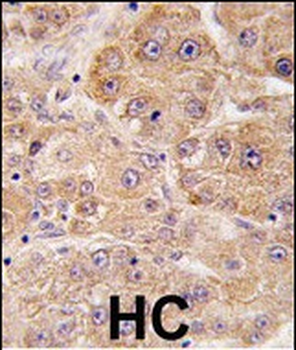You have no items in your shopping cart.
UVRAG Antibody (C-term)
Catalog Number: orb1933088
| Catalog Number | orb1933088 |
|---|---|
| Category | Antibodies |
| Description | UVRAG Antibody (C-term) |
| Clonality | Polyclonal |
| Species/Host | Rabbit |
| Isotype | Rabbit IgG |
| Conjugation | Unconjugated |
| Reactivity | Human, Mouse |
| Form/Appearance | Purified polyclonal antibody supplied in PBS with 0.09% (W/V) sodium azide. This antibody is prepared by Saturated Ammonium Sulfate (SAS) precipitation followed by dialysis against PBS. |
| UniProt ID | Q9P2Y5 |
| MW | 78151 Da |
| Tested applications | IF, IHC-P, WB |
| Dilution range | IF - 1:10-50, WB - 1:1000, IHC-P - 1:100-500 |
| Antibody Type | Primary Antibody |
| Storage | Maintain refrigerated at 2-8°C for up to 2 weeks. For long term storage store at -20°C in small aliquots to prevent freeze-thaw cycles |
| Research Area | Cardiovascular Research, Cell Biology |
| Note | For research use only |

Fluorescent image of U251 cells stained with UVRAG (C-term) antibody. U251 cells were treated with Chloroquine (50 μM, 16 h), then fixed with 4% PFA (20 min), permeabilized with Triton X-100 (0.2%, 30 min). Cells were then incubated with UVRAG (C-term) primary antibody (1:200, 2 h at room temperature). For secondary antibody, Alexa Fluor 488 conjugated donkey anti-rabbit antibody (green) was used (1:1000, 1 h). Nuclei were counterstained with Hoechst 33342 (blue) (10 μg/ml, 5 min). UVRAG immunoreactivity is localized to autophagic vacuoles in the cytoplasm of U251 cells.

Formalin-fixed and paraffin-embedded human hepatocarcinoma tissue reacted with hUVRAG (C-term), which was peroxidase-conjugated to the secondary antibody, followed by DAB staining. This data demonstrates the use of this antibody for immunohistochemistry; clinical relevance has not been evaluated.

Immunofluorescence staining of Autophagy UVRAG antibody on Methanol-fixed HeLa cells.

Immunoprecipitation and western blot analysis of anti-UVRAG Pab in 293T cells. UVRAG is immunoprecipitated (Lane 2) and detected in 293T cell transiently transfected with mouse UVRAG (Lane 1). Detection of endogenous UVRAG is shown in 293T cells (Lane 3) but is reduced by UVRAG siRNA transfection (Lane 4).
UVRAG Antibody (C-term) (orb1933088)
Participating in our Biorbyt product reviews program enables you to support fellow scientists by sharing your firsthand experience with our products.
Login to Submit a Review


